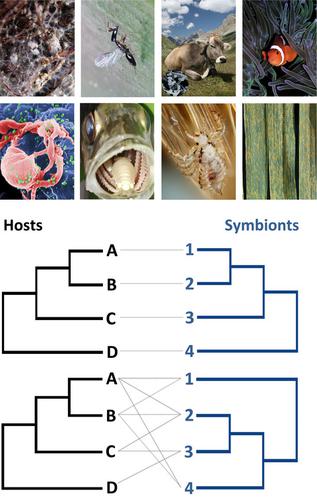当前位置:
X-MOL 学术
›
Ecol. Lett.
›
论文详情
Our official English website, www.x-mol.net, welcomes your
feedback! (Note: you will need to create a separate account there.)
A broadscale analysis of host-symbiont cophylogeny reveals the drivers of phylogenetic congruence
Ecology Letters ( IF 7.6 ) Pub Date : 2021-05-14 , DOI: 10.1111/ele.13757 Alexander Hayward 1 , Robert Poulin 2 , Shinichi Nakagawa 3
Ecology Letters ( IF 7.6 ) Pub Date : 2021-05-14 , DOI: 10.1111/ele.13757 Alexander Hayward 1 , Robert Poulin 2 , Shinichi Nakagawa 3
Affiliation

|
Symbioses exert substantial biological influence, with great evolutionary and ecological relevance for disease, major evolutionary transitions, and the structure and function of ecological communities. Yet, much remains unknown about the patterns and processes that characterise symbioses. A major unanswered question is the extent to which symbiont phylogenies mirror those of their hosts and if patterns differ for parasites and mutualists. Addressing this question offers fundamental insights into evolutionary processes, such as whether symbionts typically codiverge with their hosts or if diversity is generated via host switches. Here, we perform a meta-analysis of host-symbiont phylogenetic congruence, encompassing 212 host-symbiont cophylogenetic studies that include ~10,000 species. Our analysis supersedes previous qualitative assessments by utilising a quantitative framework. We show that symbiont phylogeny broadly reflects host phylogeny across biodiversity and life-history, demonstrating a general pattern of phylogenetic congruence in host-symbiont interactions. We reveal two key aspects of symbiont life-history that promote closer ties between hosts and symbionts: vertical transmission and mutualism. Mode of symbiosis and mode of transmission are intimately interlinked, but vertical transmission is the dominant factor. Given the pervasiveness of symbioses, these findings provide important insights into the processes responsible for generating and maintaining the Earth's rich biodiversity.
中文翻译:

宿主-共生体共系统发育的大规模分析揭示了系统发育一致性的驱动因素
共生体发挥着巨大的生物学影响,对疾病、主要进化转变以及生态群落的结构和功能具有重大的进化和生态相关性。然而,关于表征共生的模式和过程,仍有许多未知之处。一个主要的悬而未决的问题是共生系统发育在多大程度上反映了宿主的系统发育,以及寄生虫和共生者的模式是否不同。解决这个问题提供了对进化过程的基本见解,例如共生体是否通常与其宿主共同发散,或者多样性是否通过宿主交换机产生。在这里,我们对宿主共生系统发育一致性进行了荟萃分析,包括 212 项宿主共生系统发育研究,其中包括约 10,000 个物种。我们的分析通过利用定量框架取代了以前的定性评估。我们表明共生体系统发育广泛反映了生物多样性和生活史中的宿主系统发育,证明了宿主-共生体相互作用中系统发育一致性的一般模式。我们揭示了促进宿主和共生体之间更密切联系的共生体生命史的两个关键方面:垂直传播和共生体。共生方式和传播方式密切相关,但垂直传播是主导因素。考虑到共生的普遍性,这些发现提供了对负责产生和维持地球丰富生物多样性的过程的重要见解。证明了宿主-共生体相互作用中系统发育一致性的一般模式。我们揭示了促进宿主和共生体之间更密切联系的共生体生命史的两个关键方面:垂直传播和共生体。共生方式和传播方式密切相关,但垂直传播是主导因素。考虑到共生的普遍性,这些发现提供了对负责产生和维持地球丰富生物多样性的过程的重要见解。证明了宿主-共生体相互作用中系统发育一致性的一般模式。我们揭示了促进宿主和共生体之间更密切联系的共生体生命史的两个关键方面:垂直传播和共生体。共生方式和传播方式密切相关,但垂直传播是主导因素。考虑到共生的普遍性,这些发现提供了对负责产生和维持地球丰富生物多样性的过程的重要见解。但垂直传播是主导因素。考虑到共生的普遍性,这些发现提供了对负责产生和维持地球丰富生物多样性的过程的重要见解。但垂直传播是主导因素。考虑到共生的普遍性,这些发现提供了对负责产生和维持地球丰富生物多样性的过程的重要见解。
更新日期:2021-07-12
中文翻译:

宿主-共生体共系统发育的大规模分析揭示了系统发育一致性的驱动因素
共生体发挥着巨大的生物学影响,对疾病、主要进化转变以及生态群落的结构和功能具有重大的进化和生态相关性。然而,关于表征共生的模式和过程,仍有许多未知之处。一个主要的悬而未决的问题是共生系统发育在多大程度上反映了宿主的系统发育,以及寄生虫和共生者的模式是否不同。解决这个问题提供了对进化过程的基本见解,例如共生体是否通常与其宿主共同发散,或者多样性是否通过宿主交换机产生。在这里,我们对宿主共生系统发育一致性进行了荟萃分析,包括 212 项宿主共生系统发育研究,其中包括约 10,000 个物种。我们的分析通过利用定量框架取代了以前的定性评估。我们表明共生体系统发育广泛反映了生物多样性和生活史中的宿主系统发育,证明了宿主-共生体相互作用中系统发育一致性的一般模式。我们揭示了促进宿主和共生体之间更密切联系的共生体生命史的两个关键方面:垂直传播和共生体。共生方式和传播方式密切相关,但垂直传播是主导因素。考虑到共生的普遍性,这些发现提供了对负责产生和维持地球丰富生物多样性的过程的重要见解。证明了宿主-共生体相互作用中系统发育一致性的一般模式。我们揭示了促进宿主和共生体之间更密切联系的共生体生命史的两个关键方面:垂直传播和共生体。共生方式和传播方式密切相关,但垂直传播是主导因素。考虑到共生的普遍性,这些发现提供了对负责产生和维持地球丰富生物多样性的过程的重要见解。证明了宿主-共生体相互作用中系统发育一致性的一般模式。我们揭示了促进宿主和共生体之间更密切联系的共生体生命史的两个关键方面:垂直传播和共生体。共生方式和传播方式密切相关,但垂直传播是主导因素。考虑到共生的普遍性,这些发现提供了对负责产生和维持地球丰富生物多样性的过程的重要见解。但垂直传播是主导因素。考虑到共生的普遍性,这些发现提供了对负责产生和维持地球丰富生物多样性的过程的重要见解。但垂直传播是主导因素。考虑到共生的普遍性,这些发现提供了对负责产生和维持地球丰富生物多样性的过程的重要见解。











































 京公网安备 11010802027423号
京公网安备 11010802027423号